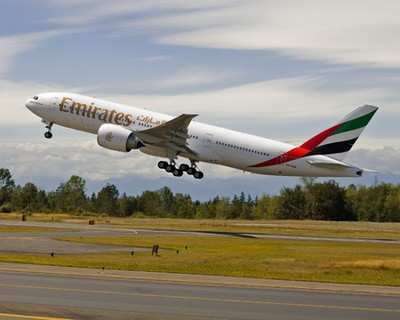But Will The Boom Turn Bust?
 The United Arab Emirates and India
have combined for hundreds upon hundreds of commercial aircraft
orders over the past few years, with more on the way... and now,
the race is on to build facilities to maintain and repair all those
jets.
The United Arab Emirates and India
have combined for hundreds upon hundreds of commercial aircraft
orders over the past few years, with more on the way... and now,
the race is on to build facilities to maintain and repair all those
jets.
Dubai -- which rivals the state of Texas for bragging rights to
the "bigger is better" philosophy -- plans a
56-square-mile aerospace complex dubbed "Aviation City," complete
with mega-airport and a $1.5 billion maintenance facility capable
of handling up to 400 planes at once. A similar boom is also
underway in India... where no fewer than nine brand-new, and
massive, complexes are in the works, for such companies as Boeing,
EADS, and Lufthansa Technik AG.
That's fine now, as times are good... but as many airline
insiders know, things can (and inevitably will) turn in a
heartbeat. The Wall Street Journal reports the current boom could
turn bust if predictions of a global economic collapse come to
fruition. A drop in the airline industry throughout the Middle East
and southwest Asia could mean dozens of brand new, high-tech... and
empty... buildings.
"If all the proposed... facilities are built, then there will be
a global glut, let alone regional," says Bharat Malkani, chairman
of Mumbai-based maintenance provider Max Aerospace and Aviation
Ltd. To be truly successful, he adds, companies will need "the
ability to sustain lean periods when the industry goes through a
downturn."
Both countries are banking heavily on maintenance contracts to
fuel their already-booming economies. The Confederation of Indian
Industry predicts revenue of $4 billion annually by 2012 in MRO
work -- and to do it, Indian maintenance facilities will need to
duke it out with their rivals in Dubai, less than a three-hour
flight away.
In the short term, that also means competition for skilled
technicians, maintenance engineers... and, for that matter, crews
to build the facilities. Each is taking a different approach to
filling the ranks, with India's efforts focused on training the
local population, while Dubai -- flush with oil revenues -- is
attracting personnel from around the world.
"If there aren't enough skilled engineers at the right price,
some facilities will have to adjust supply accordingly," said Asia
Pacific Aviation executive Peter Harbison.
India is also handicapped by its own bureaucracy, and a lack of
available infrastructure... whereas the UAE has a friendlier
business climate, and plenty of space. The difference has already
cost one Indian maintenance provider to set its sights on Dubai:
Livewel Aviation Services, based in Mumbai, altered its original
plans to open an $80 million MRO facility in India, and now plans
to build in Dubai instead.
"Dubai is also close to all countries including India and our
target customers will be not only from India, but also from Middle
Eastern and European markets," said Livewel Chief Executive Burzin
Daver.

In addition to local contracts, MRO operations in Dubai also
hope to lure European, and even American, carriers to send business
their way. Rob Mionis, chief executive of Dubai Aerospace
Enterprise's engineering and manufacturing unit, says most
facilities in Europe and the US are "older operations with inherent
limitations in terms of technology and capabilities," whereas
"Dubai's center will remove such limitations."
Time will tell whether that business plan will bear fruit... or,
survive an industry-wide downturn. Stay tuned.
 ANN's Daily Aero-Term (12.19.25): Ultrahigh Frequency (UHF)
ANN's Daily Aero-Term (12.19.25): Ultrahigh Frequency (UHF) NTSB Prelim: Cirrus Design Corp SR22T
NTSB Prelim: Cirrus Design Corp SR22T Classic Aero-TV: The Red Tail Project--Carrying the Torch of the Tuskegee Airmen
Classic Aero-TV: The Red Tail Project--Carrying the Torch of the Tuskegee Airmen Aero-News: Quote of the Day (12.19.25)
Aero-News: Quote of the Day (12.19.25) Airborne 12.17.25: Skydiver Hooks Tail, Cooper Rotax Mount, NTSB v NDAA
Airborne 12.17.25: Skydiver Hooks Tail, Cooper Rotax Mount, NTSB v NDAA




